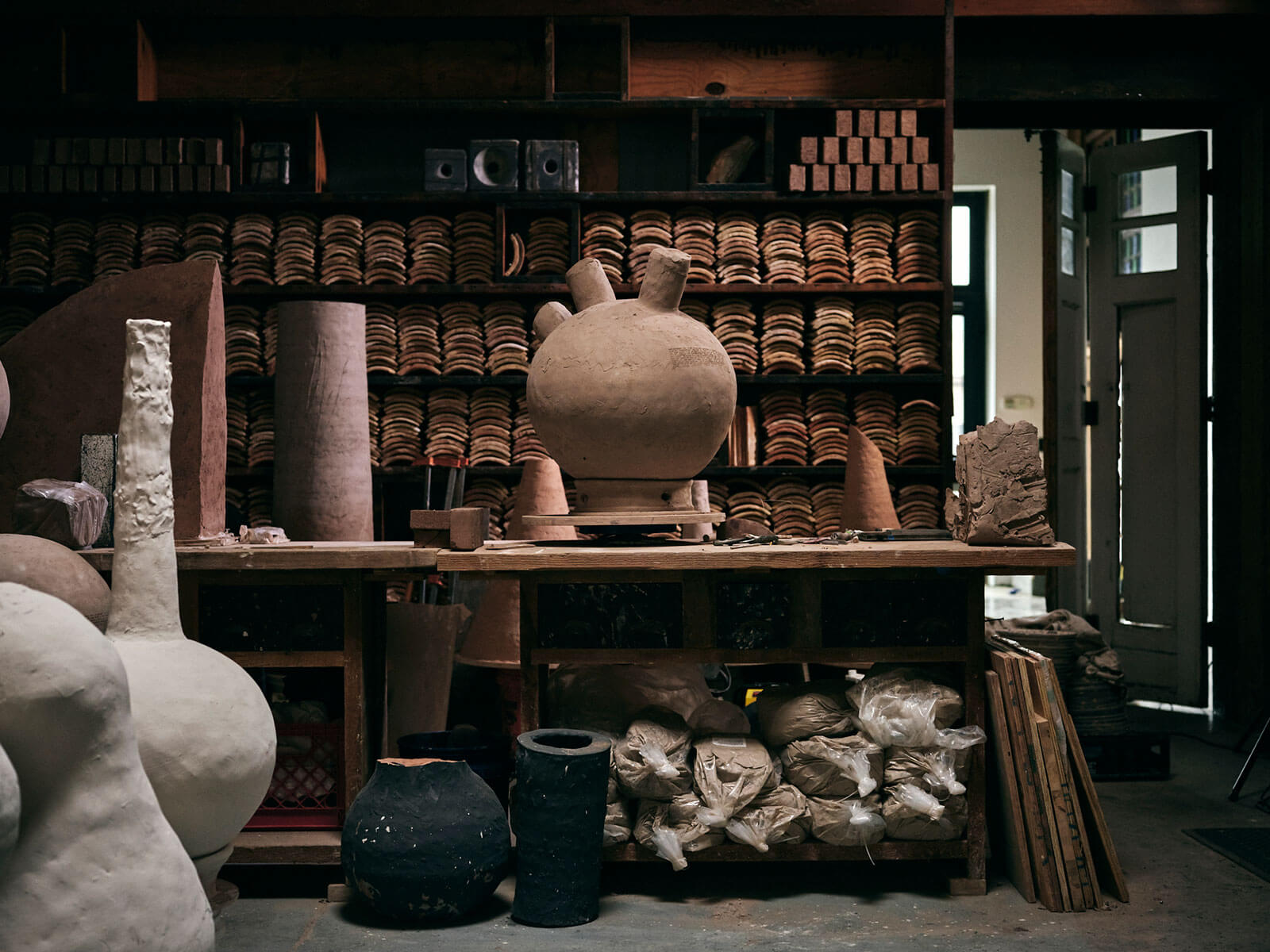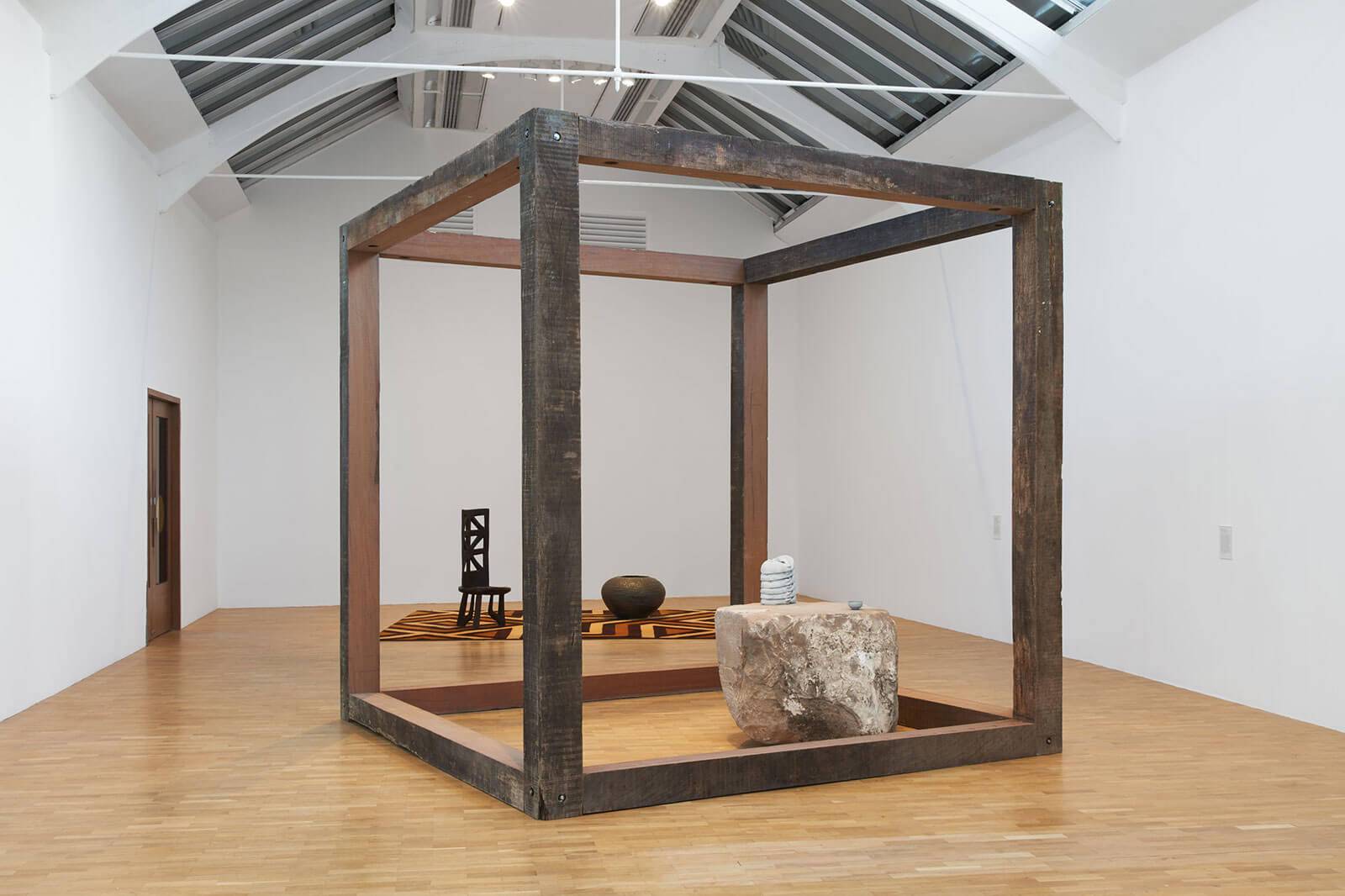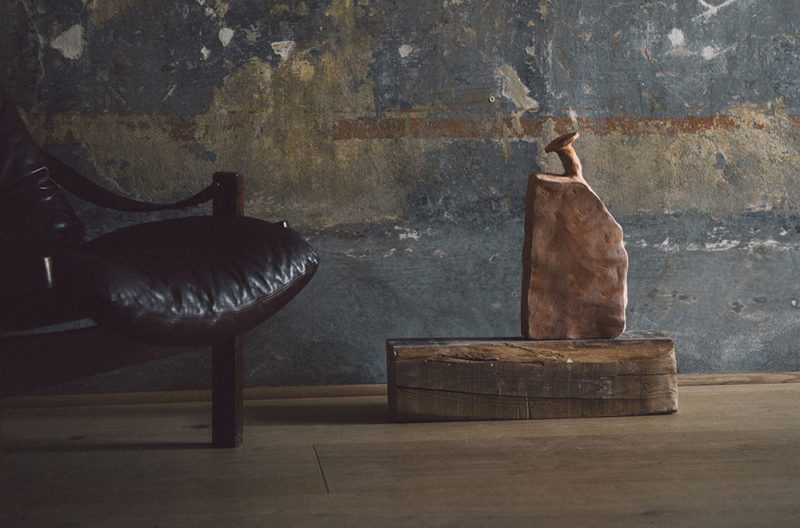Theaster Gates / A Clay Sermon
The Chicagoan artist curates a complex and thought-provoking ceramics exhibition in East London.
Whitechapel Gallery, London
29th September – 9th January 2021

Theaster Gates
COURTESY: © Theaster Gates / PHOTOGRAPH: © Chris Strong
IN A RECENT conversation for the Gagosian with potter and writer Edmund de Waal, Theaster Gates alighted on the problem with critics. “Journalism is quick to want to make our practices smaller than they are,” he said. “Or make our beings smaller, so that things can be qualified in a particular way.” And, I suspect, he’s right. The nature of deadlines demands that pieces are often written at a lick. A combination of available space and diminishing attention spans dictate that ideas have to be encapsulated simply and economically. As a result nuance and complexity can – although not always – be sacrificed on the altar of readability.

Theaster Gates’s studio
COURTESY: Theaster Gates / PHOTOGRAPH: Chris Strong
Bearing all that in mind, it’s important to point out quite how significant an artist Gates is. His body of work is anything but small and reverberates well beyond the pristine white walls of the gallery by helping to revitalise tracts of his home city, Chicago. The Dorchester Art + Housing Collaborative, for example, consists of 32 units, designed for people who receive affordable and low-income housing support that includes a theatre and dance space. The idea, he explains on his website, is “to first share culture with the folk residing in those 32 units”. He adds, in a place where “there is abject poverty, simply choosing to stay becomes a radical act, even if you didn’t intend for it to be radical.” He was also behind the restoration of the Stony Island Arts Bank, which provides the South Side of Chicago with 17,000 sq ft of space for contemporary art and archives.

Installation view: Theaster Gates: ‘A Clay Sermon’, Whitechapel Gallery, 2021
COURTESY: © Theaster Gates & White Cub / PHOTOGRAPH: © Theo Christelis
‘A Clay Sermon’ surveys Theaster’s ceramic works across the past two decades over two floors, as well as allowing the artist to pick out pieces from private and public collections that have influenced him. It’s hard to be anything other than admiring, and yet I felt strangely ambivalent as I walked through the first section of his new show. It took me a while to work out why. Obviously, there’s the fact that it’s almost impossible to translate his social impact within the confines of an art gallery but, I think it also has something to do with the exhibition’s rhythm.

Unknown Maker, ‘Face Jug’, circa 1850
COURTESY: Collection of C. Philip and Corbett Toussaint
Visitors are greeted by a quartet of vitrines. In the first, Gates has selected objects from the V&A (and elsewhere) for their links to global trade – including a jar from Zhejiang, China and an earthenware brick (an object that is threaded through the artist’s practice) to sit alongside some of his early pots – illustrating the link from ancient to contemporary.

Theaster Gates, ‘Afro-Ikebana’, 2019, COURTESY: © Theaster Gates & White Cube / PHOTOGRAPH: © Theo Christelis
An adjacent display case is devoted to colonialism and slavery, including pieces from the Ana J. and Edward J. Williams’ collection of ‘negrobilia’ (held by Stony Island Arts Bank) and a large storage jar made by the extraordinary slave potter David Drake (or ‘Dave the Potter’), who sometimes inscribed poems on his vessels at a time when literacy among slaves was illegal. There is work here that has the power to shock and examine your own past – the tobacco jar in the form of a black boy cleaning boots dating from 1840-50 instantly took me back to my childhood where it was still possible to collect golliwog badges with tokens of Robertson’s jam.

Installation view: Theaster Gates: ‘A Clay Sermon’, Whitechapel Gallery, 2021
COURTESY: © Theaster Gates & White Cub / PHOTOGRAPH: © Theo Christelis
Across the other side of the room another case contains works from contemporary ceramic artists that have informed Gates’ practice – think Coper, Rie, Leach, Ladi Kwali – while the final vitrine includes pieces by raku pioneer Paul Soldner, and Iowa-based artist Nystrom, with whom Gates studied. It’s intriguing stuff and does much to illustrate Gates’s background and thinking. However, there’s so much detail and text, the visitor is required to bob between the wall-based information boards and display cases on any number of occasions. It strikes me as a curious – and rather laborious – way to open, as if the artist is almost too keen to emphasise his place in the lineage of ceramics, to prove the size and import of his practice. Fair enough but could the cases not simply have been dotted around the exhibition instead?

Theaster Gates, ‘Power Figure’, 2019
COURTESY: © Theaster Gates & White Cub / PHOTOGRAPH: © Theo Christelis
Subsequently, things become easier to digest but, in retrospect, I needed time to fully engage with the rest of the exhibits. Which isn’t to imply the show lacks striking pieces. There’s ‘Voulkos #2’, for example, a huge, dramatic vessel, made from high-fired stoneware with enamel, that Gates created during a residency at the Archie Bray Foundation for the Ceramic Arts in Montana, which Peter Voulkos helped establish.

Installation view: Theaster Gates: ‘A Clay Sermon’, Whitechapel Gallery, 2021
COURTESY: © Theaster Gates & White Cub / PHOTOGRAPH: © Theo Christelis
I also enjoyed his experiments with brick, and the desire to overturn the perceived hierarchy of materials. Captivating too is his search for ceramic role models and cultural roots that led to his interest in the tradition of mingei and his coining of the term ‘Afro-mingei’– combining the Japanese notion of folk (or heritage) craft with a black aesthetic.

Theaster Gates, ‘They believe, you breathe, they quake, you dance, they wet, you pray’, 2020
COURTESY: © Theaster Gates & White Cub / PHOTOGRAPH: © Theo Christelis
The exhibition continues upstairs and starts with a new film, A Sermon in Clay, which combines the artist’s love of music – he’s a member of a vocal ensemble, called The Black Monks – with ceramics. It has shards of beauty but meanders. However, the whole thing really blossoms in the final space, and here my previous misgivings about the show’s opening float gently away and the whole thing makes sense.

Installation view: Theaster Gates: ‘A Clay Sermon’, Whitechapel Gallery, 2021
COURTESY: © Theaster Gates & White Cub / PHOTOGRAPH: © Theo Christelis
It feels as if Gates is relaxed, completely confident in what he’s doing with clay. The room is full of recent work – from the Archie Bray Foundation residency and elsewhere – with large, organic-shaped pieces (often made from stoneware) sitting on support structures hewn from pine, ash and limestone. They feel perfectly at home in the space, seeming thoroughly contemporary but ancient all at once. It’s a compelling conclusion to an exhibition that, while not flawless, is often fascinating.







